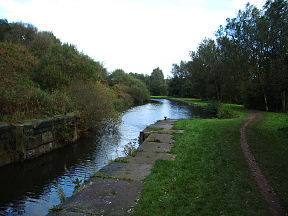Sankey Brook Navigation
| Sankey Canal | |
|---|---|

The Sankey Canal
|
|
| Specifications | |
| Locks | 3 |
| Status | Partly restored |
| History | |
| Original owner | Sankey Brook Navigation Co |
| Principal engineer | Henry Berry |
| Date of act | 1755 |
| Date of first use | 1757 |
| Date closed | 1963 |
| Geography | |
| Start point | St Helens |
| End point | Widnes |
| Connects to | River Mersey |
The Sankey Canal, also known as the Sankey Brook Navigation or St Helens Canal was historically in Lancashire and is now in Cheshire and Merseyside in North West England. It connects St Helens to the River Mersey at Spike Island. When opened in 1757, it followed the valley of the Sankey Brook from where the brook joined the River Mersey past Warrington to Parr at the north east of what became St Helens town centre. Extensions were constructed at the Mersey end to Fiddlers Ferry and then to Widnes, while at the northern end it was extended to Sutton. The canal was abandoned between 1931 and 1963 but has been the object of a restoration attempt since 1985 when the Sankey Canal Restoration Society was formed.
The Sankey Canal was built principally to transport coal from Haydock Collieries and Parr to the growing chemical industries of Liverpool, although iron ore and corn were important cargoes. The industries rapidly expanded, and spread along the line of the canal to St Helens, Haydock, Newton le Willows and Widnes, which were small villages until this period. The canal was an important factor in the industrial growth of the region.
The line of the canal was surveyed by Henry Berry and William Taylor, for which they charged £66. Berry, who had previously worked with Thomas Steers, Liverpool’s first dock engineer, on the Newry Canal in Northern Ireland, was Liverpool’s second dock engineer, but was appointed engineer for the navigation when the promoters convinced the Dock Trustees to release him for two days a week. It is not known whether Berry or the promoters presented the plans to parliament as an upgrade to the river navigation, despite building it as a true canal, but it is thought to be the only time a canal was authorised by parliament without anyone petitioning against it.
...
Wikipedia
